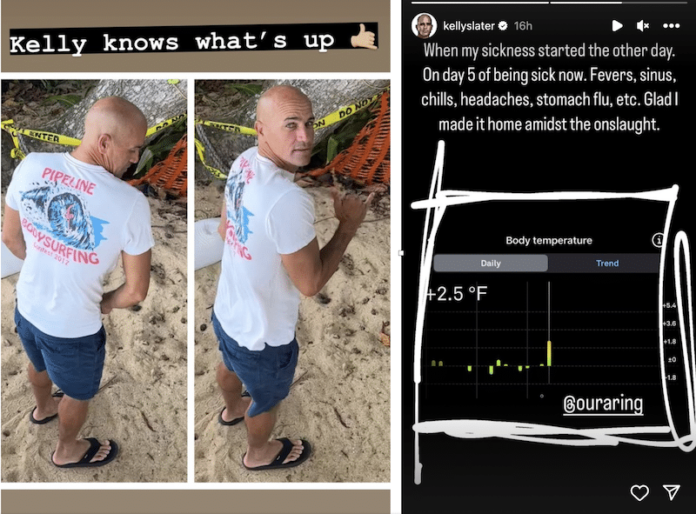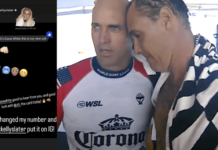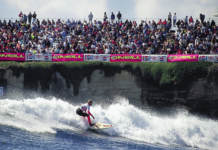
“I can’t even tie my shoelaces. Been in excruciating pain 24/7. Even the morphine doesn’t work.”
In the hot Queensland summer of 2021, Gary Elkerton, a three-time runner-up to the world title, two of ’em amid controversial circumstances, hit 321 pounds.
It’s a considerable sum by anyone’s standards, even for a man with the nickname “Kong.” Shortly afterward, the then-57-year-old appeared in a photo for his alma mater, the North Shore Boardriders. Kong saw it and feared the worst. “Are you kidding me?” he whispered to himself, examining the creases of fat around his knees. “I’m going to die!”
Radical weight fluctuations have been a part of Kong’s life ever since he started gaining mass for the Hawaiian season—he appreciated the extra 60 pounds of ballast on big waves—before shedding it all prior to the small-wave events. But this was more than a little different. Now he was gambling with his life, not the thrilled expectancy of the North Shore.
A driven man with a cat’s fury, Kong figured he could work it off. He took a job as a delivery driver, supplying restaurants with 5-gallon barrels of cooking oil and bags of rice. He also practiced intermittent fasting. By winter, manual labor and not eating for 20 hours each day had hacked away 90 pounds.
Then he blew his knee stepping out of his truck. It was the same knee he’d injured in 1985, when he was socked by a loose board at 12-foot Sunset and required 58 stitches. (The doctors back then told him he needed half a year out of the water, although he was surfing again in two weeks.)
As often happens with an aged machine, when one part goes, another follows. Kong’s right hip, the fulcrum that operated his powerful back-foot lever, started to hurt like hell. An MRI revealed advanced osteoarthritis, the doc telling him the cartilage between the femoral head and the hip socket had been gone for at least 15 years, the stress from the knee injury bringing it into relief. Kong had long figured something was wrong. His back leg was taking longer to get into position on takeoffs, but it wasn’t something he couldn’t work around.
It was the cap to some hard years: Kong had lost his beloved father, Keith, aka Bully; his old tour buddy Sunny Garcia was in a vegetative state at a Texas facility after an attempted suicide; another tour pal, John Shimooka, had taken his own life; and his one-time bête noire and friend Derek Ho had died of a heart attack at 55.
It’s around these circumstances that we interrogate our subject, a man on crutches and waiting for the $30,000 hip replacement operation paid for by kind friends, thereby circumventing the three-year public-hospital waiting period, occasionally driving to the nearby store in his $100 Ford station wagon. “I can’t even tie my shoelaces,” he says. “Been in excruciating pain 24/7. Even the morphine doesn’t work. It’s been an interesting couple of months, mate.”
DR Two weeks and you’re under the knife. Have you thought about how your life will change when you’re pain-free?
GE That’s the biggest thing I’m looking forward to. I’m sitting here right now, [and] I’ve got this one position I can sit [in]. It’s like, “Don’t move, man, whatever you do. Just stay right there!” I’m quite lucky. I’ve got a good friend taking care of me. You need help with these things. You can’t do it on your own.
DR Because you didn’t have private health insurance, you would’ve had to wait years to access the public system. Real lucky you got good pals.
GE I can’t imagine sitting around for three years like this.
DR You’d go to some dark places.
GE Listen, it’s been hard. But I’ve got a lot of good people around me. That’s important.
DR Are you married?
GE Nuh! Not married. No. Single.
DR Single and looking?
GE Ah, nuh! Very happy, mate. I got a lot of friends around. [Laughs.] But those days are over.
DR Talk to me about your dramatic weight fluctuations when you were on tour—getting big for Hawaii, then shedding it all for the beachbreak events.
GE The type of circuit we were on back then was brutal because we had Hawaii and then we had to surf in minute waves. I was quite lucky I could fluctuate my weight quickly like that. Which, in the end, is not a good thing. I wish I knew about intermittent fasting back then. It’s been a big savior with my life. If I didn’t do that a year and a half ago, I’d be dead. The doctor said, “You would’ve had a massive heart attack.”
DR How do you operate with fasting?
GE It’s a time thing—when you eat, right? So, I started off on “Warrior,” which means you’re allowed to eat between 12 and six [p.m.]. And you have to stop eating at six. Most people’s body takes 12 hours to eat all the sugar out of it, so if you stop eating at six and you’re up at seven in the morning, your body switches to keto. When you stay in the keto[genic] state, your body is eating fat. And if you do any type of exercise within that, it’s really burning the fat. Why a lot of people give up on that is they don’t see any visual results because it starts eating all the fat around your organs first, so you see nothing on your face or around your gut until months later. The photo I’ve got from when I started to now is like two different people.
DR Ninety pounds is a lot of cargo to throw overboard.
GE It’s crazy. It’s ridiculous. And you know what? Anyone can do it. You just have to be mentally strong with where you want to go with it. I’ve got a daughter who’s 17 years old. I want to see her get to 21. My surfing deteriorated completely and I wasn’t enjoying surfing at all. This is a game changer for me and a second lease on life.
DR What was it like when you stepped away from pro surfing? You milked it a little by winning three consecutive World Masters titles from 2000 through 2003. But still, it ain’t easy.
GE When it all happened, my daughter was born and I had a different responsibility. I’d moved back to Australia after living in France, and my partner at the time had a business, so there was money there. I was doing surf-coaching things on the side and
I was…kinda lost. Then I took my daughter to a swimming lesson out the back of Mullumbimby [near Byron Bay] and I didn’t agree with the way they were teaching kids to swim. So I built a massive indoor kids’ swimming center called Kong for Kids. Ran that for 12 years. Did really well—200 kids a week. I was the main teacher there. It was really cool.
DR What happened?
GE I wasn’t married, but I separated from my Brazilian partner—the mother of Luna, my daughter. I went to the Gold Coast, did some work with [surfboard company] Mt. Woodgee for a little bit, and then I moved up to the Sunshine Coast and I slothed around and blew out to 146 kilos [321 pounds]. But it’s been an interesting run. Leaving the tour is a really hard thing—when you see the train leave the station and you’ve gotta go and find something else. I’ve been very fortunate. Some people haven’t in my generation, because we didn’t make much money. My properties I owned in France, I lost to my first wife, and I still don’t own a property. I just live my life the way I’m living it right now, day by day and enjoying it.
DR That move to France when you were 22, and taking a French wife, was a dramatic shift for you—from tough son of a fisherman to urbane sophisticate.
GE I still speak fluent French. I moved there in the early ’80s. There was only Belly [Stephen Bell] and Maurice Cole there at the time. Yeah, you know what? That was a big change in my life as well, meeting [French model] Pascale [Roby]. I have to say, the pinnacle of my surfing, I really feel, was from ’85 to ’90. All those events I won—Pipe, the Triple Crowns—[were] when I was living in France. I was in France for 27 years. I was very lucky to see a lot of great things in my life, but that was one of ’em—seeing France in those early days. La Gravière, there was no one out. Just me, Maurice, Belly, and a handful of French guys who wanted to have a go at it. And obviously, living in the Médoc [on the left bank of the Gironde estuary near Bordeaux], you’ve got all the best wines in the world, which I acquired a great taste for. And their food and their culture. Everything about the French way of life, I loved.
DR You say you lost two world titles to the “incompetence of the system,” which leads into that ’93 title showdown at Pipe when Derek Ho blocked Larry Rios so you couldn’t make the final, thereby getting him the win.
GE Yeah. The one before that was even harder, with Damien [Hardman]. I love Damien, but that was the year [1987] they decided to finish the world title at Manly. I left Hawaii in the number-one position. I’d won events back to back. I should’ve been world champion. I shouldn’t have had to go to Manly to compete in minute waves. The funny thing about it, the priority rule at that stage was if the guy who had priority caught the wave, even if he couldn’t get around that section, you couldn’t catch that wave. So I was paddling back out and needed a three-point-something, and this right came and Damien was way deeper. And he took off and went straight in the whitewater. So I couldn’t catch it or I would’ve been called for an interference. If it wasn’t for that rule, I would’ve got the three-point-five. And I would’ve won the world title right there. They changed the rule two weeks later. I was like, “What the fuck?” That world title should’ve been won in Hawaii. The second one, with Curren in 1990, there were a couple of weird calls in that one. But that third one, with Derek, was the gut-wrencher. But listen, I know what should’ve happened in my heart. I had an amazing career. I wouldn’t change anything. Well, I’d change those rules. [Laughs.]
DR How does someone like you, who has ridden those highs, navigate those later years in, as your old pal Rob Bain said to me, a “peaceful contentment”?
GE It’s not easy to be traveling the world like a rock star and two years later you slip into the bushes. Life’s not easy and it’s not getting any easier.
DR It’s been a radically tragic last few years: Sunny, Derek, Shmoo. How do you react to those events?
GE [Long silence.] Fuck… It’s fuckin’ hard, dude. [Swallows tears.] Phew. Um. Phew. [Expels air.] Listen, I know Sunny was fighting depression for a long time. Sunny, Shmoo, you don’t really know what happened, but something clicked in their life, obviously, that left them feeling empty, that they had nothing. And they had a lot more to give in life. I was close to Shmoo and especially Sunny. And yeah, mate, some people, we don’t know why. I’ve never had those thoughts, thank God. I lost my dad at the same time. That was…uh…that was a whole…year…gnarly year, man. Derek, too, with him passing. You ask yourself questions, like, “What the fuck is going on here?” But the older we get, the more people start to pass away. It’s life. [Long pause.] I just wish I…I… I don’t know why Shmoo and Sunny—they had so many people around. I don’t know how that could’ve happened. That’s what I find hard to understand. They’re people who are surrounded by good people. I know that if I was in that position, I’d be putting my hand up straight away.
DR You’re an optimistic cat.
GE If you live in the past, you live in depression. If you live in the future, you got anxiety of what’s coming up. If you live in the present, you can control it—you can visualize and plan good things day by day. I’ve always been someone who’s been lucky to survive drugs and stuff back in the day, pull myself up and get back on the straight and narrow. Some people don’t have that. I knew I was very fortunate on tour, even though I behaved like a dickhead most of the time. Something I used to do that I didn’t tell anyone was everywhere I’d go, I’d go to the local hospital and go to the children’s ward and give out stickers and posters. It brought me back. I’d realize how fortunate I was, and I still look at that sometimes. I say to friends, when they’re whining about the rain or if it’s too hot, I tell ’em, “Go for a walk down the children’s ward and see the parents whose kids are in hospital. Think of the kids who are handicapped. We have a great life. We’re blessed.”
Postscript: As of press time, Kong was convalescing following hip-replacement surgery, although he was walking the day after the procedure. “I’m pain-free,” he said. “It’s unbelievable.” He was also planning a return to surfing. “My boards have been waxed and polished about a hundred times. They’re in perfect condition, just sitting there, ready for when I’m ready.”
(Editor’s note: This story first appeared in The Surfer’s Journal accompanied by a wonderful hand-drawn portrait by Andrea Ventura. Click here to view.)





